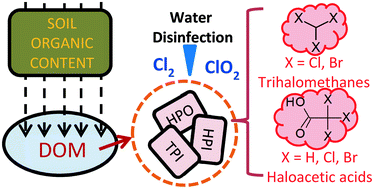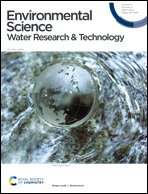Carbonaceous DBP (THMs and HAAs) formation during Cl2 and ClO2 treatment of aqueous soluble fractions of soil derived natural organic matter†
Abstract
A substantial portion of surface water dissolved organic matter is of terrestrial origin and serves as an important precursor for toxic disinfection byproduct formation. In the present study, organic matter extracted from a composite soil sample from our local area was investigated for its potential for disinfection byproduct (DBP) formation during Cl2 and ClO2 treatment. The soil organic content (SOC) was separated into base leachable organic content (OCB) and acid leachable organic content (OCA). The OCA and OCB constituents were further fractionated into hydrophobic (HPO), transphilic (TPI) and hydrophilic (HPI) constituents, based on their selective adsorption onto XAD-4 and XAD-8 resin. The isolated organic fractions were treated with 3–25 mg L−1 of Cl2 and ClO2 to evaluate their specific trihalomethane (THM) and haloacetic acid (HAA) potential. The THM formation potentials of the OCA and OCB were 251.2 and 191.3 μg per mg-C for Cl2 treatment at a 3 : 1 Cl2 : OC (organic carbon) ratio. The order of THM formation potentials of different fractions of SOC was HPO > HPI > TPI for the OCA; and HPO > TPI > HPI for the OCB during chlorine treatment. The SOC showed insignificant reactivity toward ClO2: the HPO (4.23 μg per mg-C) and TPI (1.03 μg per g-C) fractions of the OCA only resulted in the formation of a small amount of THMs. Similarly, for HAAs: Cl2 (ClO2) treatment of the OCA and OCB generated 67.2 (11.1) and 114.9 (11.86) μg per mg-C. The distribution pattern of four THMs and nine HAAs was clearly different for the Cl2 and ClO2 treatment of the SOC. Tribromomethane was the dominant THM for Cl2 treatment, whereas bromodichloromethane was the most frequently detected THM for ClO2. The di-HAAs dominated the HAA species in the case of Cl2; in contrast tri-HAAs were the only HAA species formed during ClO2 treatment of the SOC. Overall, these results provide important insights pertaining to the significance of soil derived organic fractions on the formation of DBPs during Cl2 and ClO2 treatment of surface water.



 Please wait while we load your content...
Please wait while we load your content...